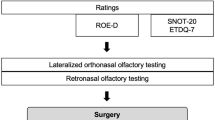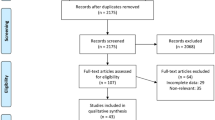Abstract
This study aimed to comprehend the influence of surgery on the lateral nasal wall, primarily focusing on the inferior turbinates, and its impact on olfactory function. A systematic review was carried out utilizing electronic databases like PubMed, Cochrane (including various registers and databases), and Web of Science. No restrictions were imposed on publication year or language. The PRISMA criteria guided study selection, and predefined inclusion and exclusion criteria were employed. Risk of bias assessment for randomized controlled trials (RCTs) utilized the “Revised Cochrane risk-of-bias tool for randomized trials (RoB 2),” while Hawker et al. scale evaluated the quality of non-RCT studies. The review encompassed nine studies after rigorous selection and bias assessment. All studies unanimously demonstrated improved olfactory function following surgery on the inferior turbinate. Different surgical techniques and olfactory assessment methods were employed across studies. Evaluation encompassed pre- and post-surgery olfactory measurements. Most studies employed the Visual Analogue Scale (VAS) and commercial smell test kits (like Sniffin’ Stick Test). The Nasal Obstruction Symptom Evaluation (NOSE) scale was used in two studies, and the butanol threshold test in one. Olfactory improvement was measured through enhanced patient numbers or nasal cavities, often expressed via VAS scores. One study utilized both patient count and VAS scores. A few studies also employed NOSE scale and olfactory threshold measurements. All studies consistently concluded that olfactory function post-surgery was superior to preoperative measures. The collective evidence strongly suggests that surgery on inferior turbinates has a positive impact on olfactory function, as indicated by the studies reviewed. Nonetheless, for a comprehensive understanding of surgical efficacy, future research should incorporate randomized controlled trials featuring control groups. This would facilitate the establishment of optimal surgical techniques for specific indications and the formulation of practical guidelines.

Similar content being viewed by others
Data Availability
The data sets used and/or analyzed during the current study are available from the corresponding author upon request.
References
Chastain JB, Sindwani R Anatomy of the Orbit, Lacrimal Apparatus, and Lateral Nasal Wall. Otolaryngol Clin North Am [Internet]. 2006 Oct 1 [cited 2023 Apr 3];39(5):855–64. https://linkinghub.elsevier.com/retrieve/pii/S0030666506001058
Georgakopoulos B, Hohman MH, Le PH, Anatomy (2022) Head and Neck, Nasal Concha. StatPearls [Internet]. Nov 14 [cited 2023 Aug 1]; https://www.ncbi.nlm.nih.gov/books/NBK546636/
Chiu AG, Palmer JN, Adappa ND Atlas of endoscopic sinus and skull base surgery.:344
Stucker FJ, De Souza C, Kenyon GS, Lian TS, Draf W, Schick B (2009) Rhinology and facial plastic surgery. Rhinology and facial plastic surgery. Springer, Berlin Heidelberg, pp 1–946
Branigan B, Tadi P, Physiology (2022) Olfactory. StatPearls [Internet]. May 8 [cited 2023 Apr 3]; https://www.ncbi.nlm.nih.gov/books/NBK542239/
Escada P (2013) Localization and Distribution of Human Olfactory Mucosa in the Nasal Cavities. Acta Med Port [Internet]. Jun 21 [cited 2023 Apr 17];26(3):200–7. https://www.actamedicaportuguesa.com/revista/index.php/amp/article/view/4238
de Rezende Pinna F, Ctenas B, Weber R, Hilario Saldiva P, Louis Voegels R Olfactory neuroepithelium in the superior and middle turbinates: which is the optimal biopsy site? Orig Artic Int Arch Otorhinolaryngol 17(2):131–138
Kim DH, Hong YK, Jeun SS, Park JS, Lim DJ, Kim SW et al Endoscopic Endonasal Transsphenoidal Approach from the Surgeon Point of View. J Craniofac Surg [Internet]. 2017 Jun 1 [cited 2023 Aug 1];28(4):959–62. https://journals.lww.com/jcraniofacialsurgery/Fulltext/2017/06000/Endoscopic_Endonasal_Transsphenoidal_Approach_From.25.aspx
Fujimoto Y, Ramos HF, maRiani PP, Romano FR CukieRt arthur, BoR-seng-sHu edson, Superior Turbinectomy: Role for a Two-surgeon Technique in Endoscopic Endonasal Transsphenoidal Surgery-Technical Note
Croy I, Nordin S, Hummel T Olfactory disorders and quality of life–an updated review. Chem Senses [Internet]. 2014 Mar [cited 2023 Aug 4];39(3):185–94. https://pubmed.ncbi.nlm.nih.gov/24429163/
Nurse LA, Duncavage JA (2009) Surgery of the Inferior and Middle Turbinates. Otolaryngol Clin N Am [Internet]. [cited 2023 Apr 7];42:295–309. https://www.clinicalkey.com/#!/content/playContent/1-s2.0-S0030666509000127?returnurl=https:%2F%2Flinkinghub.elsevier.com%2Fretrieve%2Fpii%2FS0030666509000127%3Fshowall%3Dtrue&referrer=https:%2F%2Fpubmed.ncbi.nlm.nih.gov%2F
Page MJ, McKenzie JE, Bossuyt PM, Boutron I, Hoffmann TC, Mulrow CD et al (2021) The PRISMA 2020 statement: an updated guideline for reporting systematic reviews. BMJ. ;372
RoB 2 A revised Cochrane risk-of-bias tool for randomized trials | Cochrane Bias [Internet]. [cited 2023 Apr 13]. https://methods.cochrane.org/bias/resources/rob-2-revised-cochrane-risk-bias-tool-randomized-trials
Hawker S, Payne S, Kerr C, Hardey M, Powell J Appraising the evidence: reviewing disparate data systematically. Qual Health Res [Internet]. 2002 [cited 2023 Jul 27];12(9):1284–99. https://pubmed.ncbi.nlm.nih.gov/12448672/
Chevretton EB, Hopkins C, Black IM, Tierney P, Smeeton NC Degloving of the inferior turbinates: pilot study to assess the effectiveness of a new technique in turbinate reduction. J Laryngol Otol [Internet]. 2003 Nov [cited 2023 Apr 7];117(11):866–70. https://www.cambridge.org/core/journals/journal-of-laryngology-and-otology/article/abs/degloving-of-the-inferior-turbinates-pilot-study-to-assess-the-effectiveness-of-a-new-technique-in-turbinate-reduction/9A2C4F7ED3A324814C4BB567849172A4
Gupta P, Toran KC, Regmi D Diode Laser Turbinate Reduction in Allergic Rhinitis: A Cross-sectional Study. J Nepal Med Assoc [Internet]. 2018 Nov 1 [cited 2023 Apr 7];56(214):949–52. https://pubmed.ncbi.nlm.nih.gov/31065141/
Mahato NB, Regmi D, Bista M Diode Laser Reduction of Symptomatic Inferior Turbinate Hypertrophy. J Nepal Med Assoc [Internet]. 2018 Nov 1 [cited 2023 Apr 11];56(214):958–62. https://pubmed.ncbi.nlm.nih.gov/31065143/
Singh S, Ramli RR, Wan Mohammad Z, Abdullah B Coblation versus microdebrider-assisted turbinoplasty for endoscopic inferior turbinates reduction. Auris Nasus Larynx [Internet]. 2020 Aug 1 [cited 2023 Apr 7];47(4):593–601. https://www.sciencedirect.com/science/article/pii/S0385814620300341?via%3Dihub
Bäck LJJ, Hytönen ML, Malmberg HO, Ylikoski JS Submucosal Bipolar Radiofrequency Thermal Ablation of Inferior Turbinates: A Long-Term Follow-up With Subjective and Objective Assessment. Laryngoscope [Internet]. 2002 [cited 2023 Apr 7]; https://onlinelibrary.wiley.com/doi/full/https://doi.org/10.1097/00005537-200210000-00019
Garzaro M, Pezzoli M, Landolfo V, Defilippi S, Giordano C, Pecorari G Radiofrequency inferior turbinate reduction: Long-term olfactory and functional outcomes. Otolaryngol - Head Neck Surg [Internet]. 2012 Jan [cited 2023 Apr 7];146(1):146–50. https://aao-hnsfjournals.onlinelibrary.wiley.com/doi/https://doi.org/10.1177/0194599811423008
Garzaro M, Pezzoli M, Pecorari G, Landolfo V, Defilippi S, Giordano C Radiofrequency inferior turbinate reduction: An evaluation of olfactory and respiratory function. Otolaryngol - Head Neck Surg [Internet]. 2010 Sep [cited 2023 Apr 7];143(3):348–52. https://aao-hnsfjournals.onlinelibrary.wiley.com/doi/https://doi.org/10.1016/j.otohns.2010.06.908
Rhee C-S, Kim D-Y, Won T-B, Lee H-J, Park S-W, Kwon T-Y et al Changes of Nasal Function After Temperature-Controlled Radiofrequency Tissue Volume Reduction for the Turbinate. Laryngoscope [Internet]. 2001 [cited 2023 Apr 7];111(1):153–8. https://doi.org/10.1097/00005537-200101000-00026
Olszewska E, Sieskiewicz A, Kasacka I, Rogowski M, Zukowska M, Soroczyńska J et al Cytology of nasal mucosa, olfactometry and rhinomanometry in patients after CO2 laser mucotomy in inferior turbinate hypertrophy. Folia Histochem Cytobiol [Internet]. 2010 [cited 2023 Apr 7];48(2):217–21. https://journals.viamedica.pl/folia_histochemica_cytobiologica/article/view/4224
Friedman M, Caldarelli DD, Venkatesan TK, Pandit R, Lee Y, Venkatesan TK et al Endoscopic Sinus Surgery With Partial Middle Turbinate Resection: Effects on Olfaction. Laryngoscope [Internet]. 1996 [cited 2023 Apr 7];106(8):977–81. https://doi.org/10.1097/00005537-199608000-00012
ODETOYINBO O Complications following total inferior turbinectomy: facts or myths? Clin Otolaryngol Allied Sci [Internet]. 1987 [cited 2023 Apr 11];12(5):361–3. https://pubmed.ncbi.nlm.nih.gov/3427800/
Mohammadi MA, Review on A (2016) [cited 2023 Apr 11]; https://www.webofscience.com/wos/woscc/full-record/WOS:000410536300218
Funding
The authors have no funding or financial relationships to disclose.
Author information
Authors and Affiliations
Corresponding author
Ethics declarations
Ethical Approval
Ethical approval for the manuscript was appropriately waived by the relevant institutional review board or ethics committee. The decision to waive ethical approval is often based on the nature of the research and the absence of direct involvement with human subjects. In this particular case, as a systematic review, the study does not involve direct interactions or interventions with individuals. Consequently, the ethics committee deemed that formal ethical approval was not necessary due to the observational and analytical nature of the study. The manuscript diligently adheres to ethical standards as outlined in the Helsinki Declaration. The Helsinki Declaration provides a comprehensive framework to ensure the ethical treatment of human subjects in medical research. In this study, all aspects involving human subjects’ rights, safety, and well-being have been carefully considered and incorporated to maintain the highest level of ethical integrity.
Informed Consent
In the context of the manuscript, the requirement for informed consent has been deemed unnecessary due to the study’s methodology. As a systematic review, the research involves the synthesis and analysis of previously published data rather than direct interactions with participants. Given that this study does not involve any personal data collection or patient involvement, the concept of obtaining informed consent is not applicable.
Competing interests
There is no conflict of interest.
Additional information
Publisher’s Note
Springer Nature remains neutral with regard to jurisdictional claims in published maps and institutional affiliations.
Rights and permissions
Springer Nature or its licensor (e.g. a society or other partner) holds exclusive rights to this article under a publishing agreement with the author(s) or other rightsholder(s); author self-archiving of the accepted manuscript version of this article is solely governed by the terms of such publishing agreement and applicable law.
About this article
Cite this article
Esteves, S., Sousa-Machado, A., Silva, A. et al. Olfactory Function and Surgery of the Lateral Nasal Wall – Systematic Review. Indian J Otolaryngol Head Neck Surg (2024). https://doi.org/10.1007/s12070-024-04739-z
Received:
Accepted:
Published:
DOI: https://doi.org/10.1007/s12070-024-04739-z




